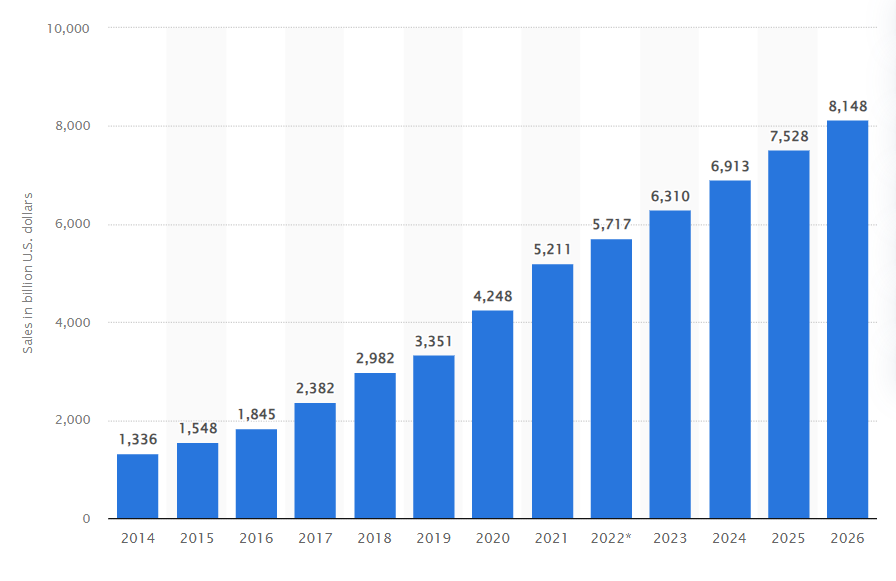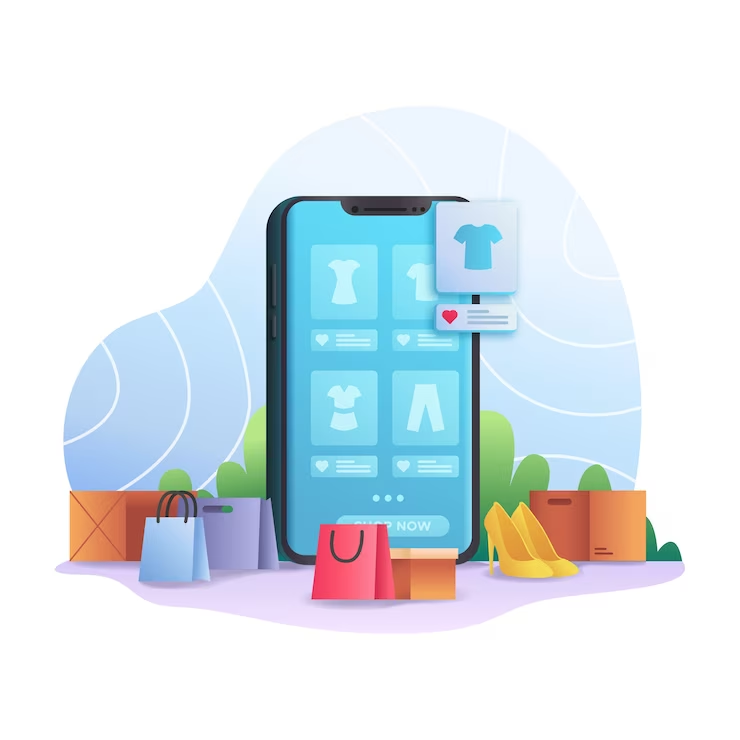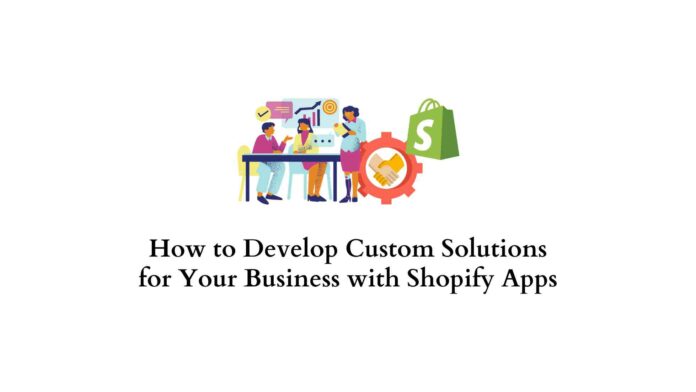Last updated - November 29, 2023
The e-commerce sector is at the forefront of the technological revolution that is reshaping entire economic sectors. Due to the convenience of online shopping and the widespread availability of the Internet, e-commerce is a rapidly expanding sector of the economy. And at the heart of this digital marketplace, Shopify proves to be a potent force that helps businesses of all sizes launch successful online stores.
E-commerce has experienced exponential growth, and it doesn’t appear to be slowing down. Statista predicts that worldwide e-commerce sales will increase from 3.3 trillion US dollars in 2019 to a stunning 6.9 trillion US dollars by 2024. Businesses now have the opportunity to take advantage of worldwide prospects because of this meteoric rise.


Need for Personalized Solutions
The e-commerce world is full of opportunities, but it is not a uniform environment. The issue stems from the fact that every company is as distinctive as its goods or services. While widely available, off-the-shelf e-commerce solutions frequently fall short of meeting the unique demands and objectives of enterprises.
It would be like attempting to put a square peg into a round hole. The same is true for companies hoping to succeed in the e-commerce industry. Generic solutions can’t always meet the unique needs, branding, and customer experiences that organizations desire.
This is the precise situation in which the idea of tailored solutions is relevant. Businesses are seeing enormous potential in customizing their online storefronts to correspond with their own identities and ambitions in an increasingly competitive e-commerce industry. The catalysts of change in the e-commerce industry, Shopify apps, are at the center of this customizing journey.
Personalized solutions are not only about website customization but also about mobile applications, as well as website adaptability to mobile devices. Any entrepreneur who has ever contacted a custom mobile application development company knows about the importance of the entire spectrum of personalization.
Understanding Shopify and Its Ecosystem
Shopify is more than just an e-commerce platform; it’s a complete set of tools that helps companies build, run, and grow their online presence. Since its founding in 2006, Shopify has grown to become an international powerhouse, supporting over a million businesses in more than 175 countries Its user-friendly interface and versatile capabilities have made it the preferred option for startups, small businesses, and even well-known brands.
Why is Shopify so well-liked? To begin with, it provides a whole range of services, including website creation, product administration, safe payment channels, and even marketing tools. Shopify can also serve companies at any stage of development, from startups to corporations, thanks to its scalability.
Its huge theme library, which makes it easy for businesses to create online storefronts with eye-catching design elements, is one of its main advantages. Shopify provides a blank canvas on which to unleash creativity, with options ranging from sleek, minimalistic designs to colorful and varied layouts.
Shopify App Ecosystem
But Shopify’s extensive and thriving ecosystem of apps is what makes it stand out. The Shopify App Store, a veritable gold mine of programs that greatly expand the capability of the platform, is at the center of this ecosystem.
Consider the App Store to be a toolbox, with each app standing in for a distinct tool. With the help of these tools, businesses may improve their online storefronts, optimize their processes, increase sales, and improve consumer experiences. Over 8,000 apps are currently available in the Shopify App Store, and this figure is steadily increasing.
It is impossible to overestimate the importance of this environment. It frees companies from the limitations of a one-size-fits-all strategy and enables them to customize their Shopify stores to meet their specific needs. And the king of this ecosystem is custom solutions.
Advantages of Custom Solutions


Tailored for Your Needs
Pre-made solutions may have their limitations. They provide a predetermined set of functions and aesthetics, requiring firms to work within their limitations. Customized solutions, on the other hand, let firms design their online storefronts to their particular specifications. It distinguishes between a generic website and one that stands out as a genuine representation of your brand.
You may address unique business needs with custom Shopify apps and solutions, whether it’s designing a user interface that appeals to your target market or including features that simplify your business processes. The limitations of pre-made templates or generic features no longer apply to you. The options are as endless as your creativity when it comes to using your online store as a canvas.
Competitor Advantage
Imagine yourself competing in a race where everyone is wearing the same pair of shoes. Now visualize having a pair of precisely developed, individually-made sneakers that fit your particular gait and aesthetic. You have an advantage.
Custom Shopify apps give you the upper hand in the e-commerce space. They give you the ability to develop features, functions, and user interfaces that are not just good but outstanding. Your competitive advantage is your exceptionality. While your rivals use generic solutions, you have a set of tools that are tailored to your advantages and the demands of your clients.
This competitive advantage is a long-term benefit. By raising consumer happiness, brand loyalty, and ultimately your bottom line, it creates the foundation for long-term success.
Additional Advantages of Custom Solutions
- Scalability. Customized solutions can expand with your company. Custom Shopify apps may be built to scale effortlessly, in contrast to off-the-shelf apps that may not be able to handle rising traffic or a growing product catalog.
- Better user experience. Higher customer engagement and satisfaction are a result of tailored user interfaces and experiences.
- Brand coherence. Every element of your online store will be in line with your brand identity, thanks to custom solutions.
- Streamlined Processes. You can create custom functionality to fit your particular business operations. This simplifies processes, lessens manual labor, and decreases errors.
- Data Protection. To protect your company and your customers’ data, custom apps might give priority to security features. You can put in place sophisticated security measures that directly target your weaknesses.
Developing Custom Solutions
After examining the necessity of custom solutions, let’s now examine how to implement these solutions. Custom Shopify app development is a well-organized process that includes several crucial steps to make sure your idea becomes a reality.
- Planning. Every successful endeavor starts with a plan. Define your unique app’s goals, boundaries, and features. What specific issues will it resolve, and how will it benefit your company? This stage of planning is similar to drawing out the plans for your ideal home.
- Design. Designers produce wireframes and mockups to conceptualize the app’s layout and user experience, just like an architect creates blueprints before beginning construction. The design phase is primarily about aesthetics, making sure that your software is both aesthetically appealing and functional.
- Development. Once the design is complete, developers take over to bring your unique app to life. They create the code, incorporate features, and guarantee smooth interactions. Imagine this stage as the brick-by-brick construction of your ideal home.
- Testing. Thorough testing is necessary before making your software accessible to the public. To fix any kinks or issues, developers run the software through rigorous testing. Making certain that the final product meets the highest standards during this phase is similar to quality control in manufacturing.
- Deployment. It’s time to deploy the app to your Shopify store after it sails through testing. This stage is comparable to relocating into your newly built, ideal home, replete with all the customizations you had in mind.
- Constant Upkeep. Your personalized software needs constant care, much like a house does. To keep the app functioning at its best, developers keep track of it and update it.
Making the Best Development Partner Selection
The path to advancement can be complicated, so finding the proper mentor is essential. You have two main options: working with a specialized Shopify app development company or hiring an internal development team.
Employing a team internally gives you total control over the development process. However, you may need to hire, manage, and train developers, which can be resource-intensive. Additionally, smaller enterprises might find it too expensive.
On the other hand, companies that design Shopify apps are professionals in their sector. They provide a lot of knowledge, a unique set of skills, and a track record of successfully delivering unique solutions. They also offer flexibility, allowing you to scale your collaboration as your project expands. Your bespoke app development journey will be easy and successful if you choose the correct partner.
Types of Custom Solutions


Adaptive User Interfaces
Your user interface (UI) and user experience (UX) can make all the difference in the wide e-commerce market where various companies compete for customers’ attention. A well-designed UI/UX can convert infrequent users into devoted clients.
Custom UI/UX design involves adjusting your Shopify store’s appearance, feel, and navigation to better reflect your brand identity and target market. It involves designing an online environment that effortlessly directs customers through their purchasing process from the time they arrive on your website until they complete the transaction.
Custom UI/UX design’s strength resides in its capacity to:
- Boost Brand Identity. Your store can become unique and distinctive by letting its UI and UX reflect the personality of your business.
- Improve User Flow. Custom interfaces make shopping easier, lower friction, and increase conversions.
- Incorporate Customer Insights. Data and user behavior can influence tailored interfaces, ensuring that your business reflects the tastes of your customers.
- Boost Participation. An appealing UI/UX encourages browsing and repeat visits, which strengthens the feeling of connection.
- Heighten Conversion Rates. A smooth user experience enhances the chance that website visitors will become paying clients.
Take into account this figure: 38% of visitors will quit interacting with a website if the content or style is unpleasant, according to Adobe. Custom UI/UX design is your secret weapon to ensure your Shopify store not only attracts visitors but also keeps them engaged and eager to make a purchase.
Enhancing Functionality
The key to successful e-commerce is not only a well-designed store. The foundation that keeps your online business running smoothly and effectively is functionality. The main potential of custom Shopify apps lies in their ability to customize features.
Let’s explore the many features that companies can add to their Shopify stores to improve them:
- Personalization of a product catalog. The core of any online store is your product catalog. Whether it’s presenting several product variants, introducing custom filtering options, or developing interactive product displays, custom solutions let you arrange your catalog exactly as you imagine it.
- Integration of the payment gateway. In order to serve a wide range of customers, it is imperative to provide flexible payment methods. Custom apps can incorporate particular payment channels that are relevant to your target demographic, improving the shopping process.
- Process optimization for checkout. A sale could succeed or fail during the checkout process. This important process can be streamlined using unique solutions, which will increase conversion rates and decrease cart abandonment rates. You may customize features like one-click checkout, guest checkout, and custom checkout forms to meet your precise needs.
- Inventory control. To avoid overselling and stockouts, effective inventory management is essential. Custom apps can offer automated refilling, real-time inventory tracking, and tailored inventory reports.
- Customer account customization. Customized user experiences may benefit from consumer accounts. Customized dashboards, purchase history monitoring, and loyalty program integrations are a few examples of custom functionality.
- Promotions and marketing. Your consumer involvement may increase thanks to personalized marketing tools. Aside from offering individualized product recommendations and implementing targeted promotions based on user behavior, custom applications can also automate email marketing.
The best thing about bespoke functionality is that you can easily incorporate it into your already-existing Shopify store. Custom solutions are the key to unlocking new levels of efficiency and client happiness, whether you want to boost your product catalog, improve your checkout process, or fine-tune your marketing activities.
Case Studies
Success stories frequently center on the capacity for innovation, adaptability, and great customer service. Numerous businesses, both big and small, have found success with custom Shopify apps. In this section, we’ll look into actual cases of companies that developed custom Shopify apps and enjoyed outstanding success.
Allbirds
The Problem: Allbirds, a company that makes eco-friendly shoes, sought to improve the online buying experience for its customers. Their challenge was making an engaging and educational digital environment that could simulate trying on shoes in a physical store.
The Custom Solution: To construct a unique app that made use of augmented reality (AR), Allbirds worked with a Shopify app development company. Customers may digitally try on shoes with this software, exploring various styles and sizes as though they were in a physical store.
The Result: Because customers could confidently select the appropriate size and style, the AR software not only enhanced the customer experience but also decreased the number of returns. Sales at Allbirds significantly increased, and brand loyalty improved. In addition to setting them apart, this modification was entirely in line with their ethos of sustainability.
Fashion Nova
The Problem: Cart abandonment, a prevalent issue in the e-commerce sector, presented a challenge for Fashion Nova, a fast-fashion retailer. To lower cart abandonment rates and make up for lost sales, they required a solution.
The Custom Solution: Fashion Nova created a unique Shopify application that integrated chatbots powered by AI into their online business. These chatbots interacted with clients who had left their shopping carts empty by extending personalized discounts, making suggestions, and helping with the checkout procedure.
The result: The AI-powered chatbots performed exceptionally well. In Fashion Nova, abandoned cart conversion rates significantly increased, while cart abandonment rates significantly decreased. Their bottom line and customer retention have both considerably improved because of this straightforward yet clever tweak.
Gymshark
The Problem: Gymshark, a fitness apparel company, wanted to give its customers a personalized purchasing experience. They wanted to make sure that customers discovered products that complemented their interests and fitness objectives.
The Custom Solution: Gymshark invested in a custom app that employed machine learning algorithms to analyze user behavior and preferences. The app modified the shopping experience by offering unique product recommendations and fitness advice based on this data.
The Result: The customized software turned Gymshark’s online store into a personal shopper and fitness advisor. Customers expressed more happiness, and the brand experienced a significant rise in average order value and repeat business. The unique solution not only increased revenue but also enhanced Gymshark’s standing as a company that values its customers.
Costs and ROI: Investment vs. Returns


A strategic choice that necessitates rigorous cost and return analysis is to invest in the creation of custom Shopify apps. Here, we’ll explain how to assess a company’s return on investment (ROI) and break down the costs related to developing a custom app.
- Costs of development. The upfront cost of creating a customized Shopify app might differ significantly depending on its complexity, features, and the hourly rates of the development team. It’s critical to obtain thorough quotes from development companies or independent contractors and to account for conceivable extra costs.
- Costs of maintenance. After you release your app, regular upkeep is essential to keep it operating properly and compatible with Shopify updates. Bug patches, upgrades, and enhancements often incur maintenance expenditures.
- Marketing expenses. You’ll want a marketing expenditure to draw people to your app. This can include the cost of developing content, running ads, working with influencers, and optimizing apps for stores.
- Calculating ROI. To calculate the return on investment (ROI) of your app, weigh its development, maintenance, and marketing expenses against the advantages it offers. Benefits could include more sales, lower operating expenses, better customer satisfaction, and stronger brand loyalty. Your app is a wise investment if your ROI is good.
Keep in mind that the ROI of a custom Shopify app involves more than just short-term profit margins. Long-term gains might also include better customer retention, a higher customer lifetime value, and a greater brand reputation. Consider all aspects of how the app affects your organization when assessing ROI.
Ready-made Application Solutions for the Shopify Store
It’s crucial to look into the plethora of ready-made applications offered in the Shopify App Store and custom solutions, which offer personalized benefits for your Shopify store. These apps can help you save time and money by improving certain parts of your e-commerce business. Here, we’ll present a few of the top Shopify apps for 2023:
- Oberlo. Oberlo is a necessity if you work in the dropshipping industry. You may add and fulfill products from diverse vendors with ease because of its simplified approach to product sourcing and management.
- ReConvert Cross-Sell & Upsell. Increase the average order value of your customers with customized upsell and cross-sell offers. You can make post-purchase offers with this software that are challenging to refuse.
- Yotpo Reviews. Social proof is very important. Yotpo assists you in gathering and displaying client testimonials, images, and ratings to foster credibility and increase sales.
- SEO Manager. With SEO Manager, you can easily search engine optimize your store. It provides tools for enhancing alt tags, meta descriptions, and other SEO components.
- Smile: Rewards & Loyalty. Boost client loyalty by offering prizes. You may design a personalized loyalty program using Smile to promote recurrent purchases.
- Recart Messenger Marketing. Recart uses the popular messaging app Facebook Messenger to automate cart abandonment reminders, deliver order updates, and more.
- Tidio Live Chat. Through live chat, enhance customer service and interact with visitors immediately. Tidio provides automation and chatbots to speed up your support process.
Conclusion
Custom Shopify apps have emerged as powerful tools that empower businesses to provide exceptional customer experiences, streamline operations, and achieve remarkable success.
Customization is a strategic necessity, not just a choice. For this reason, staying competitive in the e-commerce environment requires an awareness of the potential of personalized solutions.











